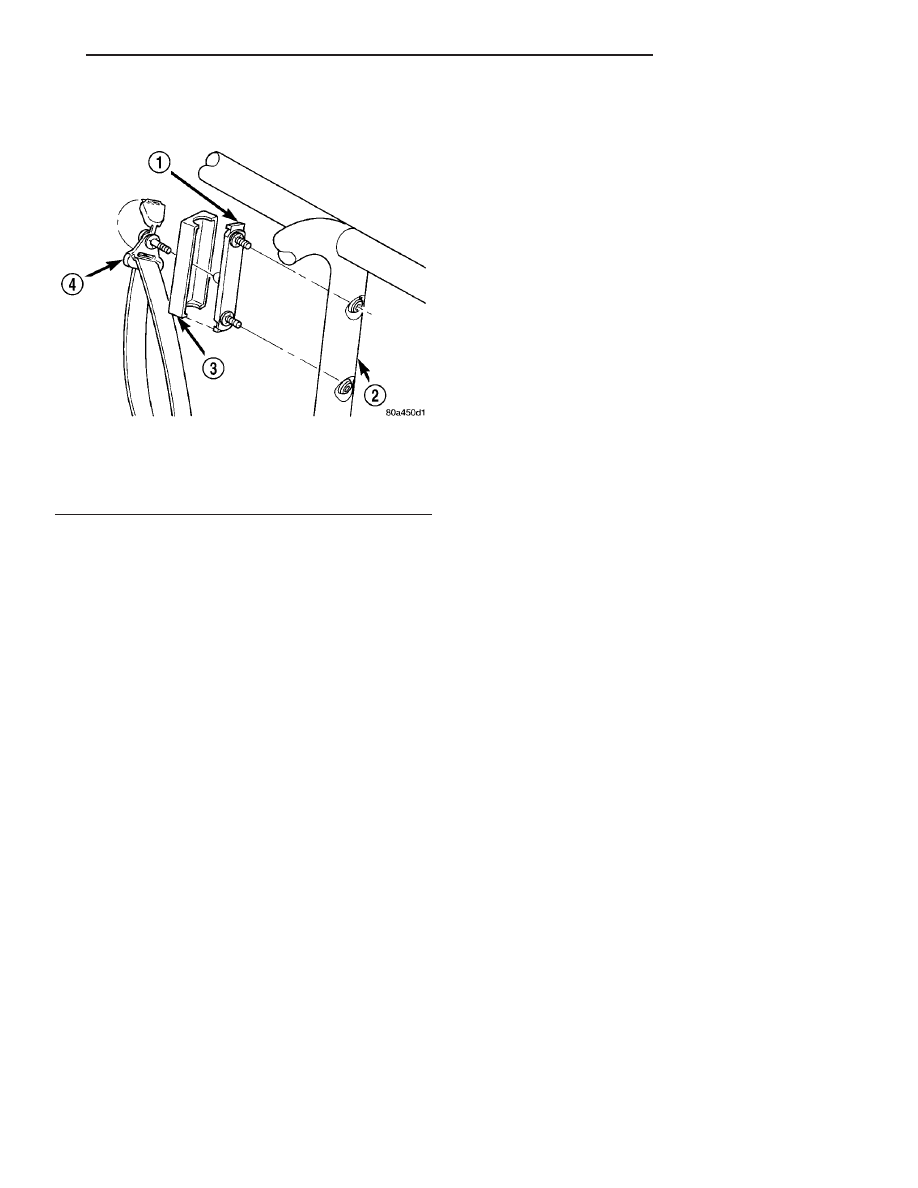Jeep Wrangler TJ. Manual - part 328

secures the turning loop to the height adjuster on the
upper sport bar (Fig. 42).
(2) Remove the screw that secures the shoulder
belt turning loop to the height adjuster.
(3) Remove the front seat belt turning loop and the
support/guide washer from the height adjuster.
(4) Unsnap and remove the trim cover from the
front seat belt turning loop height adjuster to access
the screws that secure the adjuster to the upper
sport bar.
(5) Remove the two screws that secure the height
adjuster to the upper sport bar.
(6) Remove the front seat belt turning loop height
adjuster from the upper sport bar.
INSTALLATION
WARNING:
TO
AVOID
PERSONAL
INJURY
OR
DEATH, DURING AND FOLLOWING ANY SEAT BELT
OR CHILD RESTRAINT ANCHOR SERVICE, CARE-
FULLY INSPECT ALL SEAT
BELTS,
BUCKLES,
MOUNTING HARDWARE, RETRACTORS, TETHER
STRAPS, AND ANCHORS FOR PROPER INSTALLA-
TION, OPERATION, OR DAMAGE. REPLACE ANY
BELT
THAT
IS
CUT,
FRAYED,
OR
TORN.
STRAIGHTEN
ANY
BELT
THAT
IS
TWISTED.
TIGHTEN ANY LOOSE FASTENERS. REPLACE ANY
BELT THAT HAS A DAMAGED OR INOPERATIVE
BUCKLE OR RETRACTOR. REPLACE ANY BELT
THAT HAS A BENT OR DAMAGED LATCH PLATE
OR
ANCHOR
PLATE.
REPLACE
ANY
CHILD
RESTRAINT ANCHOR OR THE UNIT TO WHICH THE
ANCHOR IS INTEGRAL THAT HAS BEEN BENT OR
DAMAGED. NEVER ATTEMPT TO REPAIR A SEAT
BELT
OR
CHILD
RESTRAINT
COMPONENT.
ALWAYS REPLACE DAMAGED OR FAULTY SEAT
BELT AND CHILD RESTRAINT COMPONENTS WITH
THE CORRECT, NEW AND UNUSED REPLACEMENT
PARTS LISTED IN THE DAIMLERCHRYSLER MOPAR
PARTS CATALOG.
(1) Position the front seat belt turning loop height
adjuster onto the upper sport bar (Fig. 42). Be cer-
tain that the word “Up” stamped on the adjuster is
properly oriented.
(2) Install and tighten the two screws that secure
the seat belt turning loop height adjuster to the
upper sport bar. Tighten the screws to 43 N·m (32 ft.
lbs.).
(3) Align the trim cover over the front seat belt
turning loop height adjuster and, using hand pres-
sure, press firmly and evenly on the cover until it
snaps into place over the adjuster on the upper sport
bar.
(4) Position the support/guide washer and the
front seat belt turning loop onto the height adjuster.
(5) Install and tighten the screw that secures the
front seat belt turning loop to the height adjuster.
Tighten the screw to 43 N·m (32 ft. lbs.).
(6) Fold and snap the trim cover for the seat belt
turning loop back into place over the screw that
secures the turning loop to the height adjuster.
Fig. 42 Front Turning Loop Height Adjuster
1 - ADJUSTER
2 - SPORT BAR
3 - TRIM COVER
4 - TURNING LOOP
TJ
RESTRAINTS
8O - 37
SEAT BELT TURNING LOOP ADJUSTER (Continued)